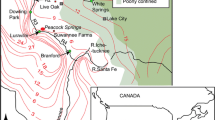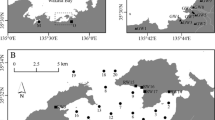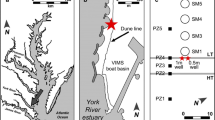Abstract
A combination of field measurements, laboratory experiments and model simulations were used to characterize the groundwater biogeochemical dynamics along a shallow monitoring well transect on a coastal hammock. A switch in the redox status of the dissolved inorganic nitrogen (DIN) pool in the well at the upland/saltmarsh interface occurred over the spring-neap tidal transition: the DIN pool was dominated by nitrate during spring tide and by ammonium during neap tide. A density-dependent reaction-transport model was used to investigate the relative importance of individual processes to the observed N redox-switch. The observed N redox-switch was evaluated with regard to the roles of nitrification, denitrification, dissimilatory nitrate reduction to ammonium (DNRA), ammonium adsorption, and variations in inflowing water geochemistry between spring and neap tides. Transport was driven by measured pressure heads and process parameterizations were derived from field observations, targeted laboratory experiments, and the literature. Modeling results suggest that the variation in inflow water chemistry was the dominant driver of DIN dynamics and highlight the importance of spring-neap tide variations in the high marsh, which influences groundwater biogeochemistry at the marsh-upland transition.







Similar content being viewed by others
References
An S, Gardner W (2002) Dissimilatory nitrate reduction to ammonium (DNRA) as a nitrogen link, versus denitrification as a sink in a shallow estuary (Laguna Madre/Baffin Bay, Texas). Mar Ecol Prog Ser 237:41–50
An S, Joye S (2001) Enhancement of coupled-denitrification by benthic photosynthesis in shallow estuarine sediments. Limnol Oceanogr 46:62–74
Anderson I, Tobias C, Neikirk B, Wetzel R (1997) Development of a process-based nitrogen mass balance for a Virginia (USA) Spartina alterniflora salt marsh: implications for net DIN flux. Mar Ecol Prog Ser 159:13–27
Bear J (1972) Dynamics of fluids in porous media. American Elsevier Publishing Company, Inc., New York
Böhlke J, Harvey J, Voytek M (2004) Reach-scale isotope tracer experiment to quantify denitrification and related processes in a nitrate-rich stream, midcontinent United States. Limnol Oceanogr 49:821–838
Böhlke J, Smith R, Miller D (2006) Ammonium transport and reaction in contaminated groundwater: application of isotope tracers and isotope fractionation studies. Water Resour Res 42:W05411. doi:10.1029/2005WR004349
Brown P, Byrne G, Hindmarsh A (1989) VODE: a variable-coefficient ODE solver. SIAM J Sci Stat Comput 10:1038–1051
Burnett W, Bokuniewicz H, Huettel M, Moore W, Taniguchi M (2003) Groundwater and pore water inputs to the coastal zone. Biogeochemistry 66:3–33
Chalmers A (1997) The ecology of Sapelo Island National Estuarine Research Reserve. NOAA Report NA470R0414, 138 pp
Cline J (1969) Spectrophotometric determination of hydrogen sulfide in natural waters. Limnol Oceanogr 14:454–458
Cotrim da Cunha L, Buitenhuis E, Le Quéré C, Giraud X, Ludwig W (2007) Potential impact of changes in river nutrient supply on global ocean biogeochemistry. Glob Biogeochem Cycles 21. doi:10.1029/2006GB002718
De Jonge V, Boynton W, D’Elia C, Elmgren R, Welsh B (1994) Responses to developments in eutrophication in four different North Atlantic estuarine systems. In: Orth R, Dyer K (eds) Changes in fluxes in estuaries: implications from science to management. Olsen & Olsen, Fredensborg
Fazzolari E, Nicolardot B, Germon J (1998) Simultaneous effects of increasing levels of glucose and oxygen partial pressures on denitrification and dissimilatory nitrate reduction to ammonium in repacked soil cores. Eur J Soil Biol 34:47–52
Froelich P, Klinkhammer G, Bender M, Luedtke N, Heath G, Cullen D, Dauphin P (1979) Early oxidation of organic matter in pelagic sediments of the eastern equatorial Atlantic: suboxic diagenesis. Geochim Cosmochim Acta 43:1075–1090
Gardner W, McCarthy M, An S, Sobolev D, Sell K, Brock D (2006) Nitrogen fixation and dissimilatory nitrate reduction to ammonium (DNRA) support nitrogen dynamics in Texas estuaries. Limnol Oceanogr 51(1, part 2):558–568
Gould W, McCready G (1982) Denitrification in several soils: inhibition by sulfur anions. Can J Microbiol 28:334–340
Hunter K, Wang H, Van Cappellen P (1998) Kinetic modeling of microbially-driven redox chemistry of subsurface environments: coupling transport, microbial metabolism, and geochemistry. J Hydrol 209:53–80
Jensen K, Cox R (1992) Effects of sulfide and low redox potential on the inhibition of nitrous oxide reduction by acetylene in Pseudomonas nautical. FEMS Microbiol Lett 96:13–18
Joye S, Hollibaugh J (1995) Sulfide inhibition of nitrification influences nitrogen regeneration in sediments. Science 270:623–625
Kartal B, Kuypers M, Lavik G, Schalk J, Op den Camp H, Jetten M, Strous M (2007) Anammox bacteria disguised as denitrifiers: nitrate reduction to dinitrogen gas via nitrite and ammonium. Environ Microbiol 9:635–642
Kelly-Gerreyn B, Trimmer M, Hydes D (2001) A diagenetic model discriminating denitrification and dissimilatory nitrate reduction to ammonium in a temperate estuarine sediment. Mar Ecol Prog Ser 220:33–46
Koop-Jakobsen K, Giblin A (2009) Anammox in tidal marsh sediments: the role of salinity, nitrogen loading and marsh vegetation. Estuar Coasts 32:238–245
Kroeger K, Charette M (2008) Nitrogen biogeochemistry of submarine groundwater discharge. Limnol Oceanogr 53:1025–1039
Luff R, Haeckel M, Wallmann K (2001) Robust and fast FORTRAN and MATLAB® libraries to calculate pH distributions in marine systems. Comput Geosci 27:157–169
Mantyla A (1987) Standard seawater comparisons updated. J Phys Oceanogr 17:543–548
Meile C (2003) Heterogeneity, uncertainty and process identification in early diagenesis: new model developments with applications to biological mixing. Dissertation, Utrecht University
Meile C, Tuncay K (2006) Scale dependence of reaction rates in porous media. Adv Water Resour 29:62–71
Moltyaner G, Klukas M, Willis C, Killey R (1993) Numerical simulations of Twin Lake natural gradient tracer tests: a comparison of methods. Water Resour Res 29:3433–3452
Moore W (1976) Sampling 228Ra in the deep ocean. Deep Sea Res 23:647–651
Moore W (1984) Radium isotope measurements using germanium detectors. Nucl Instrum Methods 223:407–411
Moore W (1996) Large groundwater inputs to coastal waters revealed by 226Ra enrichments. Nature 380:612–614
Moore W (1999) The subterranean estuary: a reaction zone of ground water and sea water. Mar Chem 65:111–125
Moore W (2003) Sources and fluxes of submarine groundwater discharge delineated by radium isotopes. Biogeochemistry 66:75–93
Moore W, Krest J, Taylor G, Roggenstein E, Joye S, Lee R (2002) Thermal evidence of water exchange through a coastal aquifer: implications for nutrient fluxes. Geophys Res Lett. doi10:1029/2002GL014923
Moore W, Sarmiento J, Key R (2008) Submarine groundwater discharge revealed by 228Ra distribution in the upper Atlantic Ocean. Nature Geosci. doi:10.1038/ngeo183
Morse J, Morin J (2005) Ammonium interaction with coastal marine sediments: influence of redox conditions on K*. Mar Chem 95:107–112
Morse J, Millero F, Cornwell J, Rickard D (1987) The chemistry of the hydrogen sulfide and iron sulfide systems in natural waters. Earth Sci Rev 24:1–42
Nixon S, Pilson M (1983) Nitrogen in estuarine and coastal marine ecosystems. In: Carpenter E, Capone D (eds) Nitrogen in the marine environment. Academic Press, New York
Nixon S, Ammerman J, Atkinson L, Berounsky V, Billen G, Boicourt W, Boynton W, Church T, Ditoro D, Elmgren R, Garber J, Giblin A, Jahnke R, Owens N, Pilson M, Seitzinger S (1996) The fate of nitrogen and phosphorus at the land sea margin of the North Atlantic Ocean. Biogeochemistry 35:141–180
Paerl H, Pinckney J, Fear J, Peierls B (1998) Ecosystem responses to internal and watershed organic matter loading: consequences for hypoxia in the eutrophying Neuse River Estuary, North Carolina, USA. Mar Ecol Prog Ser 166:17–25
Persky J (1986) The relations of ground-water quality to housing density, Cape Cod, Massachusetts. USGS Water-Resources Investigations Report 86-4093
Pinckney J, Paerl H, Tester P, Richardson T (2001) The role of nutrient loading and eutrophication in estuarine ecology. Environ Health Perspect 109:699–706
Pomeroy L, Wiegert R (eds) (1981) The ecology of a salt marsh. Springer-Verlag, New York
Porubsky W, Weston N, Joye S (2009) Benthic metabolism and the fate of dissolved inorganic nitrogen in intertidal sediments. Estuar Coast Shelf Sci 83:392–402
Press W, Teukolsky S, Vetterling W, Flannery B (1992) Numerical recipes in Fortran 77, vol 1, 2nd edn. Cambridge University Press, Cambridge
Reddy J (1993) An introduction to the finite element method, 2nd edn. McGraw Hill, Inc., New York
Redfield A (1934) On the proportions of organic derivations in seawater and their relation to the composition of plankton. In: Daniel R (ed) James Johnson memorial volume. University Press of Liverpool, Liverpool
Regnier P, Wollast R, Steefel C (1997) Long-term fluxes of reactive species in macrotidal estuaries: estimates from a fully transient, multicomponent reaction-transport model. Mar Chem 58:127–145
Risgaard-Petersen N, Nielsen L, Rysgaard S, Dalsgaard T, Meyer R (2003) Application of the isotope pairing technique in sediments where anammox and denitrification coexist. Limnol Oceanogr Methods 1:63–73
Rosenfeld J (1979) Ammonium adsorption in nearshore anoxic sediments. Limnol Oceanogr 24:356–364
Rysgaard S, Thastum P, Dalsgaard T, Christensen P, Sloth N (1999) Effects of salinity on NH4 + adsorption capacity, nitrification, and denitrification in Danish estuarine sediments. Estuaries 22:21–30
Saltel E, Hecht F (1995) EMC2 Wysiwyg 2D finite elements mesh generator. RT no 188 INRIA
Scheidegger A (1961) General theory of dispersion in porous media. J Geophys Res 66:3273–3278
Schultz G, Ruppel C (2002) Constraints on hydraulic parameters and implications for groundwater flux across the upland-estuary interface. J Hydrol 260:255–269
Seitzinger S, Gardner W, Spratt A (1991) The effect of salinity on ammonium sorption in aquatic sediments: implications for benthic nutrient recycling. Estuaries 14:167–174
Silver W, Herman D, Firestone M (2001) Dissimilatory nitrate reduction to ammonium in upland tropical forest soils. Ecology 82:2410–2416
Smith R, Baumgartner L, Miller D, Repert D, Böhlke J (2006) Assessment of nitrification potential in groundwater using short term, single-well injection experiments. Microb Ecol 51:22–35
Snyder M, Taillefert M, Ruppel C (2004) Redox zonation at the saline-influenced boundaries of a permeable surficial aquifer: effects of physical forcing on the biogeochemical cycling of iron and manganese. J Hydrol 296:164–178
Solorzano L (1969) Determination of ammonia in natural waters by the phenonlhypochlorite method. Limnol Oceanogr 14:799–801
Steefel C, MacQuarrie K (1996) Approaches to modeling of reactive transport in porous media. In: Lichtner P, Steefel C, Oelkers E (eds) Reactive transport in porous media, vol 34. Mineralogical Society of America, Washington, DC
Stookey L (1970) Ferrozine—a new spectrophometric reagent for iron. Anal Chem 42:779–781
Stumm W, Morgan J (1996) Aquatic chemistry: chemical equilibria and rates in natural waters. Wiley, New York
Tadanier C, Eick M (2002) Formulating the charge-distribution multisite surface complexation model using FITEQL. Soil Sci Soc Am J 66:1505–1517
Thamdrup B, Dalsgaard T (2002) Production of N2 through anaerobic ammonium oxidation coupled to nitrate reduction in marine sediments. Appl Environ Microbiol 68:1312–1328
Tiedje J, Sexton A, Myrold D, Robinson J (1982) Denitrification: ecological niches, competition, and survival. Antonie Leeuwenhoek 48:569–583
Tobias C, Anderson I, Canuel E, Macko S (2001) Nitrogen cycling through a fringing marsh-aquifer ecotone. Mar Ecol Prog Ser 210:25–39
Valiela I, Costa J, Foreman K, Teal J, Howes B, Aubrey D (1990) Transport of groundwater-borne nutrients from watersheds and their effects on coastal waters. Biogeochemistry 10:177–197
Valiela I, Collins G, Kremer J, Lajtha K, Geist M, Seely M, Brawley J, Sham C (1997) Nitrogen loading from coastal watersheds to receiving estuaries: new method and application. Ecol Appl 7:358–380
Van Cappellen P, Wang Y (1996) Cycling of iron and manganese in surface sediments: a general theory for the coupled transport and reaction of carbon, oxygen, nitrogen, sulfur, iron, and manganese. Am J Sci 296:197–243
Vervaet H, Boeckx P, Boko A, Van Cleemput O, Hofman G (2004) The role of gross and net N transformation processes and NH4 + and NO3 − immobilization in controlling the mineral N pool of a temperate mixed deciduous forest soil. Plant Soil 264:349–357
Vitousek P, Mooney H, Lubchenco J, Melillo J (1997) Human domination of Earth’s ecosystems. Science 277. doi:10.1126/science.277.5325.494
Vörösmarty C, Loder T III (1994) Spring-neap tidal contrasts and nutrient dynamics in a marsh-dominated estuary. Estuaries 17:537–551
Acknowledgments
We thank C. Ruppel for installation of the well transect at Moses Hammock, and M. Erickson and N. Weston for assistance in the field and in the laboratory. This publication was supported by the Georgia Sea Grant Program of the National Sea Grant College, NOAA; under NOAA Grant NA04OAR4170033 (to CM), NA06RG0029-R/WQ11 and R/WQ12A (to SBJ) and by the NSF funded Georgia Coastal Ecosystems Long Term Ecological Research (LTER) program (OCE 99-82133 and OCE 06-20959). Comments from two anonymous reviewers improved the manuscript.
Author information
Authors and Affiliations
Corresponding authors
Appendices
Appendix 1: Governing equations and implementation
Governing equations
The governing equation is based on conservation of fluid mass, expressed as:
where \( \phi \) is porosity, t is time, v is fluid velocity, \( \nabla \) is the gradient operator, and ρ is fluid density, dependent on temperature (T), salinity (S) and pressure (p). Here, ρ [kg m−3] is expressed as a linear function of salinity at a given temperature T*[°C]:
which is based on a polynomial fit to the UNESCO equation of state ρ (S,T,p), with an error <0.3 kg m−3 for 0 < S < 35, 4 < T < 35°C at p = 1 bar. Assuming constant temperature and porosity, the left hand side of Eq. 11 is approximated by \( \gamma \phi {\frac{\partial S}{\partial t}} + \beta \phi {\frac{\partial p}{\partial t}}, \) where the salinity and pressure coefficients \( \gamma = \left. {{\frac{\partial \rho }{\partial S}}} \right|_{p*,T*} ,\) \( \beta = \left. {{\frac{\partial \rho }{\partial p}}} \right|_{S*,T*} \) are set to 0.7665 kg m−3 ppt−1 and 4.55 × 10−7 kg m−3 Pa−1, respectively. Using Darcy’s law to describe the flow (e.g., Bear 1972), the fluid velocity v can be expressed as a function of material properties and the pressure field:
where κ is permeability [L2], μ is dynamic viscosity, set to 0.001 kg m−1 s−1, and g is gravitational acceleration. Combining Eqs. 11 and 13, the governing equation for the evolution of the pressure field becomes:
Solid phase chemical constituents are considered immobile, and mass conservation is expressed as:
where C i is the solid mass of species i per volume solid phase and R i the net rate of production or consumption per volume solid phase. For solutes, one can write:
where C i is the solute concentration of species i in the fluid and the reaction rate R is expressed per volume pore fluid. The diffusion–dispersion tensor, D* [L2 T−1] is defined as (Scheidegger 1961):
where \( D^{m} \) is the tortuosity corrected in situ molecular diffusion coefficient, \( \delta_{ij} \) is the Kronecker symbol, and α L and α T are longitudinal and transverse dispersivities [L], respectively.
Implementation
In each time step, the pressure field is solved (14) from which the velocity field is calculated (13). Subsequently, the evolution of the chemical species is computed (15, 16). For solutes, this is accomplished using sequential non-iterative operator splitting (Steefel and MacQuarrie 1996). In this approach, concentrations of all species are first calculated subject to advective and dispersive transport only. Without coupling between species through the reaction term, the temporal evolution for each chemical compound due to transport can be solved individually. The governing equations are discretized using a Galerkin finite element formulation and forward Euler time stepping. The resulting algebraic set of equations is solved using a diagonally preconditioned conjugate gradient solver (Reddy 1993; Meile and Tuncay 2006). The impact of the reactions is then computed by solving a set of coupled, typically stiff, ordinary differential equations for each spatial node, using the public domain solver VODE (Brown et al. 1989) with backward differentiation and the generation of full Jacobian matrix settings. Equilibrium reactions are implemented via operator splitting through mass conserving distribution functions at the end of each time step (e.g., Tadanier and Eick 2002).
The implementation of the reaction network solver has been tested by comparison to simulations with explicit rate formulations and implementations using a fully implicit Newton–Raphson approach (Regnier et al. 1997; Meile 2003). Simulations are performed at grid Peclet numbers <4, and the time step is adapted depending on Courant numbers (<1), and adjusted to resolve large temporal changes in concentrations. The finite element mesh has been produced using the open source software emc2 (Saltel and Hecht 1995), and post-processing is done with the open-source software OpenDX and within the proprietary MATLAB environment.
Appendix 2
See Table 3.
Appendix 3
See Table 4.
Rights and permissions
About this article
Cite this article
Porubsky, W.P., Joye, S.B., Moore, W.S. et al. Field measurements and modeling of groundwater flow and biogeochemistry at Moses Hammock, a backbarrier island on the Georgia coast. Biogeochemistry 104, 69–90 (2011). https://doi.org/10.1007/s10533-010-9484-8
Received:
Accepted:
Published:
Issue Date:
DOI: https://doi.org/10.1007/s10533-010-9484-8




